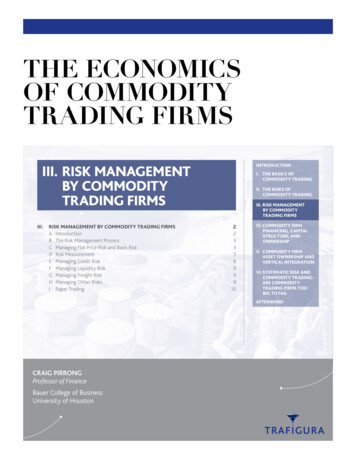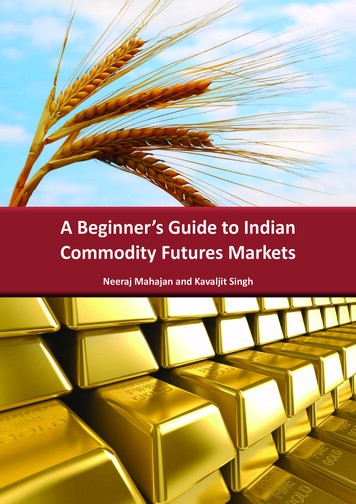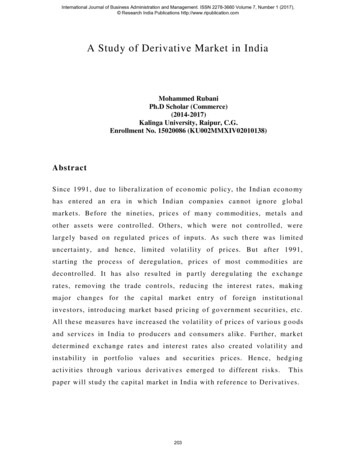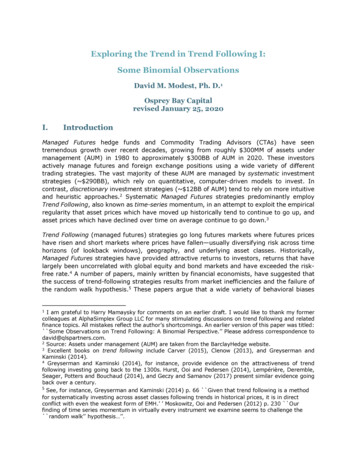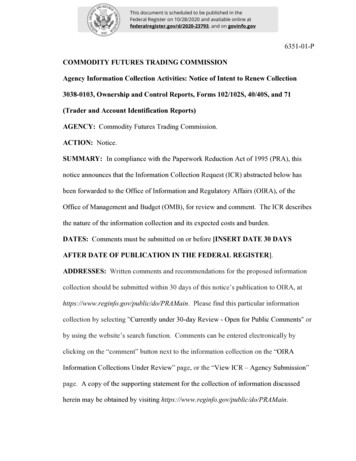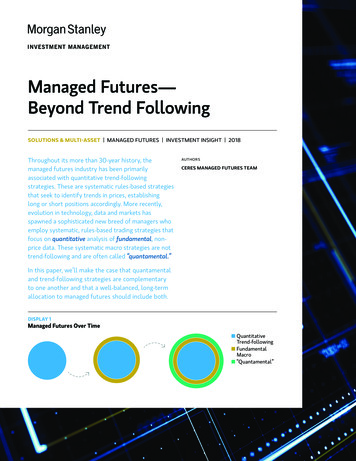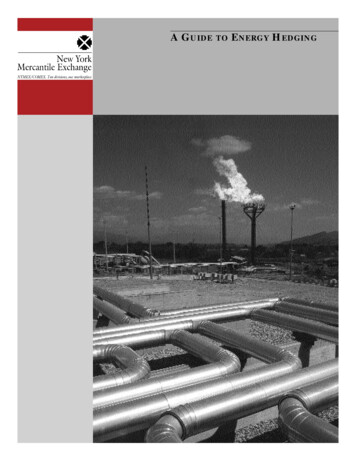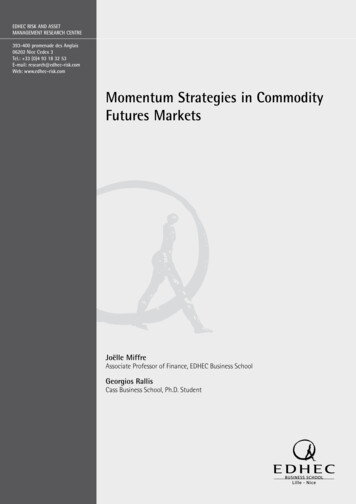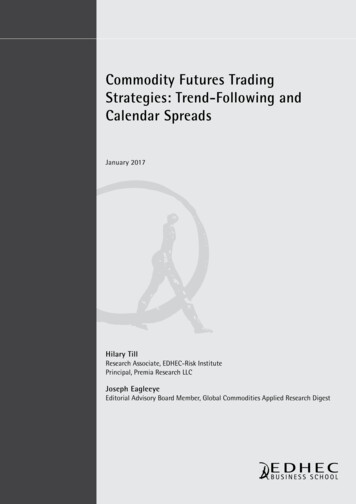
Transcription
Commodity Futures TradingStrategies: Trend-Following andCalendar SpreadsJanuary 2017Hilary TillResearch Associate, EDHEC-Risk InstitutePrincipal, Premia Research LLCJoseph EagleeyeEditorial Advisory Board Member, Global Commodities Applied Research Digest
This is a working paper version of an article that was later published in the Spring 2017 GlobalCommodities Applied Research Digest.EDHEC is one of the top five business schools in France. Its reputation is built on the high qualityof its faculty and the privileged relationship with professionals that the school has cultivatedsince its establishment in 1906. EDHEC Business School has decided to draw on its extensiveknowledge of the professional environment and has therefore focused its research on themesthat satisfy the needs of professionals.2EDHEC pursues an active research policy in the field of finance. EDHEC-Risk Institute carries outnumerous research programmes in the areas of asset allocation and risk management in both thetraditional and alternative investment universes.Copyright 2017 EDHEC
This brief article discusses the most common strategies employed by futures traders, namelytrend-following and calendar-spread trading.Commodity Trading Advisors (CTAs) and Trend-FollowingAlthough two basic types of CTAs – discretionary and trend-following – exist, the investmentcategory is dominated by trend-followers. As Campbell and Company (2013), note, “[M]ore than70% of managed futures funds [are estimated to] rely on trend-following strategies.” Trendfollowers are also known as systematic traders. The operative word here is systematic. Automatedprograms screen the markets using various technical factors to determine the beginning or endof a trend across different time frames. As Lungarella (2002) writes, “[t]he trading is based onthe systematic application of quantitative models that use moving averages, break-outs of priceranges, or other technical rules to generate the ‘buy’ and ‘sell’ signals for a set of markets”.In this investment process, automation is key and discretionary overrides of the investment processtend to be taboo. Discretionary traders occupy the other end of this bifurcated CTA spectrum. Fordiscretionary traders, Lugarella (2002) explains that “[p]ersonal experience and judgment are thebasis of trading decisions. They tend to trade more concentrated portfolios and use fundamentaldata to assess the markets, and also technical analysis to improve the timing”.Description of Trend-FollowingThe basic idea underlying trend-following strategies is that all markets trend at one time oranother. As put forward by Rulle (2003), “A trend-following program may trade as many as 80different markets globally on a 24-hour basis. Trend-followers try to capture long-term trends,typically between 1 and 6 months in duration when they occur”.Trend-followers will scan the markets with quantitative screens designed to detect a trend. Oncethe model signals a trend, a trade will be implemented. A successful trend-follower will curblosses on losing trades and let the winners ride. That is, false trends are quickly exited and realtrends are levered into. In a sense this is the distinguishing feature amongst trend-followingCTAs. The good managers will quickly cut losses and increase their exposure to winning trades. Ina sense, alpha may come from this dynamic leverage. As Fung and Hsieh (2003) explain, “ trendfollowing alpha will reflect the skill in leveraging the right bets and deleveraging the bad ones aswell as using superior entry/exit strategies. Negative alphas will be accorded to those managersthat failed to lever the right bets and showed no ability in avoiding losing bets irrespective of thelevel of overall portfolio return – luck should not be rewarded”.Proprietary Futures Traders and Calendar-Spread TradingIn contrast to highly scalable CTA programs, proprietary futures traders often specialise inunderstanding the factors that impact the spread between two (or more) of a commodityfutures contract’s delivery months. This strategy is known as calendar-spread trading. By way offurther explanation, in all commodity futures markets, a different price typically exists for eachcommodity, depending on when the commodity is to be delivered. For example, with natural gas,a futures contract whose delivery is in October will have a different price than a contract whosedelivery is in December. Accordingly, a futures trader may trade the spread between the Octobervs. December futures contracts.Calendar spread opportunities arise when a seemingly predictable one-sided commercial orinstitutional interest exists in particular futures contract(s): a proprietary trader will therebytake the other side of this “flow”. Examples of one-sided flow have occurred during seasonal3
inventory build-and-draw cycles and during the scheduled times when futures contracts arerolled in commodity indices, as discussed in the next section.Trading Strategies Keyed to Seasonal Inventory Build-and-Draw CyclesFigure 1 shows the futures curve for natural gas on 28 June, 2016. The term structure of acommodity futures market is classified as a curve because each delivery-month contract isplotted on the x-axis with their respective prices on the y-axis, thus, tracing out a curve.Figure 1Source of Data: Bloomberg.When the near-month futures contracts trade at a discount to further-delivery contracts,one terms the futures curve as being in contango. When the near-month futures contractsinstead trade at a premium to further-delivery contracts, one terms the futures curve as beingin backwardation. The yearly futures curves for natural gas in Figure 1 approximately mirror theaverage seasonal inventory build-and-draw pattern shown in Figure 2. The prices of summerand fall futures contracts typically trade at a discount to the winter contracts. The markets thusprovide a return for storing natural gas. An owner of a storage facility can buy summer naturalgas and simultaneously sell winter natural gas via the futures markets. This difference will be thestorage operator’s return for storage. When the summer futures contract matures, the storageoperator can take delivery of the physical natural gas, and inject this natural gas into storage.Later when the operator’s winter futures contract matures, the operator can make delivery ofthe physical natural gas by drawing physical natural gas out of storage for this purpose. As longas the operator’s financing and physical outlay costs are under the spread locked in through thefutures market, this operation will be profitable.To the extent that the hedging activity by storage operators causes trends in calendar spreads, aspeculator can potentially have a profitable edge in taking the other side of these trades.Cootner (1967) describes analogous price-pressure effects in the grain futures markets, keyedoff the following factors: (1) peaks and troughs in visible grain supplies, (2) peaks and troughsin hedging positions from data provided by the Commodity Exchange Authority, a predecessorto the Commodity Futures Trading Commission (CFTC), and (3) fixed calendar dates that line upon average with factors (1) and/or (2). In practice, these effects can potentially be monetisedthrough calendar spreads.4
Figure 2Sources of Data: Bloomberg, U.S. Energy Information Administration.Note: This graph specifically shows the U.S. Department of Energy’s total estimated storage data for working natural gas inventoriesaveraged over the period, 1994 to 2015.Trading Strategies Keyed to Commodity Index RollsAnother example of calendar-spread trading arises from commodity-index roll dates. Unlike anequity index, one unique aspect of a commodity futures index is that its precise rules need tospecify on what dates each of its contracts have to be rolled before the maturity of each contract.These rules are known as roll rules. The rules specify when a particular index constituent shouldbe sold and a further-maturity contract should be bought. In advance of such a procedure,speculators in futures contracts such as in the wheat market have historically sold the frontmonth while buying the next-month contract, establishing what is known as a bear-calendarspread. They would then unwind this position during index roll dates, preferably profitably, butnot always, as described in Collins (2007).ConclusionOne typically finds that institutionally-scaled futures programs employ trend-followingalgorithms. Here, the key is employing such algorithms across numerous and diverse marketssuch that the overall portfolio volatility is dampened. On the other end of the spectrum arecalendar-spread strategies. These strategies typically have limited scalability but individually canpotentially have quite consistent returns.References Campbell & Company, 2013, “Prospects for CTAs in a Rising Interesting Rate Environment,” January.Available at: files/Campbell%20CTAS.pdf. Collins, D., 2007, "Commodity Indexes Getting More Complex," Futures Magazine, July, pp. 58-61.Available at: exes-getting-more-complex. Cootner, P., 1967, “Speculation and Hedging,” Food Research Institute Studies Supplement, 7,pp. 64–105. Fung, W. and D. Hsieh, 2003, “The Risk in Hedge Fund Strategies: Alternative Alphas andAlternative Betas,” a chapter in The New Generation of Risk Management for Hedge Funds andPrivate Equity Investments (Edited by L. Jaeger), London: Euromoney Books, pp. 72-87. Lungarella, G., 2002, “Managed Futures: A Real Alternative,” swissHEDGE, Fourth Quarter, pp.9-13. Rulle, M., 2003, “Trend-Following: Performance, Risk and Correlation Characteristics,” GrahamCapital Management.5
Founded in 1906, EDHEC Business School offersmanagement education at undergraduate,graduate, post-graduate and executivelevels. Holding the AACSB, AMBA and EQUISaccreditations and regularly ranked amongEurope’s leading institutions, EDHEC BusinessSchool delivers degree courses to over 6,000students from the world over and trains5,500 professionals yearly through executivecourses and research events. The School’s‘Research for Business’ policy focuses onissues that correspond to genuine industry andcommunity expectations.Established in 2001, EDHEC-Risk Institutehas become the premier academic centrefor industry-relevant financial research. Inpartnership with large financial institutions,its team of ninety permanent professors,engineers, and support staff, and forty-eightresearch associates and affiliate professors,implements six research programmes andsixteen research chairs and strategic researchprojects focusing on asset allocation andrisk management. EDHEC-Risk Institute alsohas highly significant executive educationactivities for professionals.In 2012, EDHEC-Risk Institute signed twostrategic partnership agreements with theOperations Research and Financial Engineeringdepartment of Princeton University to set upa joint research programme in the area ofrisk and investment management, and withYale School of Management to set up jointcertified executive training courses in NorthAmerica and Europe in the area of investmentmanagement.In 2012, EDHEC-Risk Institute set up ERIScientific Beta, which is an initiative that isaimed at transferring the results of its equityresearch to professionals in the form of smartbeta indices.Copyright 2017 EDHEC-Risk InstituteFor more information, please contact:Carolyn Essid on 33 493 187 824or by e-mail to: carolyn.essid@edhec-risk.comEDHEC-Risk Institute393 promenade des AnglaisBP 3116 - 06202 Nice Cedex 3FranceTel: 33 (0)4 93 18 78 24EDHEC Risk Institute—Asia1 George Street#07-02Singapore 049145Tel: 65 6438 0030EDHEC Risk Institute—Europe10 Fleet Place, LudgateLondon EC4M 7RBUnited KingdomTel: 44 207 871 6740EDHEC Risk Institute—France16-18 rue du 4 septembre75002 ParisFranceTel: 33 (0)1 53 32 76 30www.edhec-risk.com
Trading Strategies Keyed to Seasonal Inventory Build-and-Draw Cycles Figure 1 shows the futures curve for natural gas on 28 June, 2016. The term structure of a . Private Equity Investments (Edited by L. Jaeger), London: Euromoney Books, pp. 72-87. Lungarella, G., 2002, "Managed Futures: A Real Alternative," swissHEDGE, Fourth Quarter, pp.
